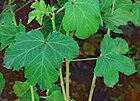Note: This is a project under development. The articles on this wiki are just being initiated and broadly incomplete. You can Help creating new pages.
Difference between revisions of "Abelmoschus esculentus - Bhenda, ಬೆಂಡೆಕಾಯಿ, भिंडी, வெண்டி/பெண் விரல், ലേഡിഫിംഗർ, भेंडी"
(→Photo Gallery) |
|||
| Line 39: | Line 39: | ||
===Flower=== | ===Flower=== | ||
| − | {{Flower|Bisexual|Axillary|Yellow|Many|Pedicel slender, inarticulate, about 0.5-2 cm long, epicalyx 9-12, free, base rarely connate, segments about 1 cm long, calyx 5 lobed}} | + | {{Flower|Bisexual|Axillary|Yellow|Many|Pedicel slender, inarticulate, about 0.5-2 cm long, epicalyx 9-12, free, base rarely connate, segments about 1 cm long, calyx 5 lobed|Flowering: June-August}} |
===Fruit=== | ===Fruit=== | ||
| − | {{Fruit|Capsule|||Ovoid-cylindric, apex beaked, dehiscent with longitudinal slits towards the base, densely hispid with simple hairs|Seed many|}} | + | {{Fruit|Capsule|||Ovoid-cylindric, apex beaked, dehiscent with longitudinal slits towards the base, densely hispid with simple hairs|Seed many|Fruiting: June-August}} |
===Other features=== | ===Other features=== | ||
Revision as of 15:25, 23 January 2021
Abelmoschus esculentus is an annual plant growing about 1.5 metres tall. The plant is widely cultivated in warm temperate to tropical areas. It has various other edible and medicinal uses as well as being the source of a good fibre.
Contents
- 1 Uses
- 2 Parts Used
- 3 Chemical Composition
- 4 Common names
- 5 Properties
- 6 Habit
- 7 Identification
- 8 List of Ayurvedic medicine in which the herb is used
- 9 Where to get the saplings
- 10 Mode of Propagation
- 11 How to plant/cultivate
- 12 Season to grow
- 13 Required Ecosystem/Climate
- 14 Kind of soil needed
- 15 Commonly seen growing in areas
- 16 Photo Gallery
- 17 References
- 18 External Links
Uses
Digestive problems, Syphilis, Cuts, Wounds, Boils, Dysuria, Skin problems, Ardor urinae, Gonorrhoea, Dandruff. [1]
Parts Used
Chemical Composition
The ripe fruits contain quercetin, hyperin (hyperoside), hydrolysate of precipitated mucilage, proanthocyanidins, D-glucose, D-glucuronic and galacturonic acids. Fresh flowers contain flavonol glycosides and anthocyanins.[2]
Common names
| Language | Common name |
|---|---|
| Kannada | Bende Kaayi |
| Hindi | Bhendi, Bhindi |
| Malayalam | Venda, Venta |
| Tamil | Ventai, Vendai |
| Telugu | Benda, Bendakaya |
| Marathi | Benda, Bhajichi-bhendi |
| Gujarathi | NA |
| Punjabi | NA |
| Kashmiri | NA |
| Sanskrit | Bbhenda, Darvika |
| English | Okra ladies Finger |
Properties
Reference: Dravya - Substance, Rasa - Taste, Guna - Qualities, Veerya - Potency, Vipaka - Post-digesion effect, Karma - Pharmacological activity, Prabhava - Therepeutics.
Dravya
Rasa
Guna
Veerya
Vipaka
Karma
Prabhava
Habit
Identification
Leaf
| Kind | Shape | Feature |
|---|---|---|
| Simple | Alternate | Palmately lobed, transversely orbicular, about 4-13 x 5-16 cm across, base cordate, 5-7 nerved, lobes about 3-7, ovate-oblong, ovate-triangular, with about 2-3 lobules |
Flower
| Type | Size | Color and composition | Stamen | More information |
|---|---|---|---|---|
| Bisexual | Axillary | Yellow | Many | Pedicel slender, inarticulate, about 0.5-2 cm long, epicalyx 9-12, free, base rarely connate, segments about 1 cm long, calyx 5 lobed |
Fruit
| Type | Size | Mass | Appearance | Seeds | More information |
|---|---|---|---|---|---|
| Capsule | Ovoid-cylindric, apex beaked, dehiscent with longitudinal slits towards the base, densely hispid with simple hairs | Seed many | Fruiting: June-August |
Other features
List of Ayurvedic medicine in which the herb is used
Where to get the saplings
Mode of Propagation
How to plant/cultivate
Seed - sow early spring in a warm greenhouse. The seed germinates in 27 days at 15°c or 6 days at 35°c.[5]
Season to grow
The three main planting seasons for Okra are February-March, June-July and October-November.[6]
Required Ecosystem/Climate
Adjustment of climatic factors helps in taking at least one (summer) crop in hills, two or even three (summer, kharif and late kharif) crops in the east, west and north Indian plains and almost year-round cultivation under moderate climate in south India.[7]
Kind of soil needed
Okra requires a long, warm and humid growing period.
Commonly seen growing in areas
Tropical area, Sub tropical area
Photo Gallery
References
- ↑ Uses
- ↑ Chemical composition
- ↑ Common names
- ↑ Morphology
- ↑ Cultivation
- ↑ Season to grow
- ↑ Required Ecosystem/Climate
- ↑ Cite error: Invalid
<ref>tag; no text was provided for refs namedPhoto Gallery
External Links
- Pages with reference errors
- Ayurvedic Herbs known to be helpful to treat Digestive problems
- Ayurvedic Herbs known to be helpful to treat Syphilis
- Ayurvedic Herbs known to be helpful to treat Cuts
- Ayurvedic Herbs known to be helpful to treat Wounds
- Ayurvedic Herbs known to be helpful to treat Boils
- Ayurvedic Herbs known to be helpful to treat Dysuria
- Ayurvedic Herbs known to be helpful to treat Skin problems
- Ayurvedic Herbs known to be helpful to treat Ardor urinae
- Ayurvedic Herbs known to be helpful to treat Gonorrhoea
- Ayurvedic Herbs known to be helpful to treat Dandruff
- Herbs with Seeds used in medicine
- Herbs with Fruits used in medicine
- Herbs with common name in Kannada
- Herbs with common name in Hindi
- Herbs with common name in Malayalam
- Herbs with common name in Tamil
- Herbs with common name in Telugu
- Herbs with common name in Marathi
- Herbs with common name in Sanskrit
- Herbs with common name in English
- Habit - Shrub
- Index of Plants which can be propagated by Seeds
- Herbs that are commonly seen in the region of Tropical area
- Herbs that are commonly seen in the region of Sub tropical area
- Herbs
- Malvaceae








